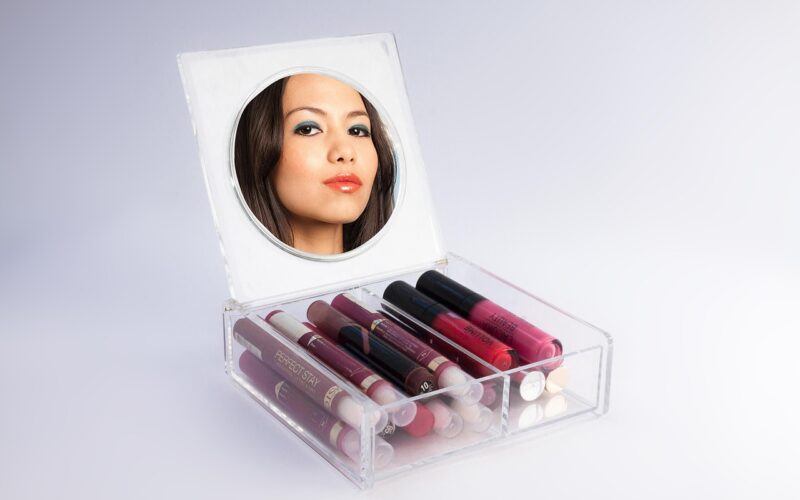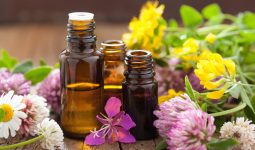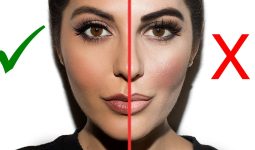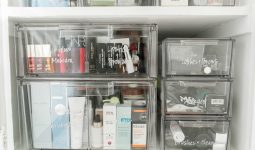Making your own lip gloss is a fun and rewarding DIY project that lets you create the perfect product for your lips.
Whether you’re looking for a glossy shine, a hint of color, or nourishing benefits, understanding the right ingredients is key to creating your ideal formula.
The basic components of homemade lip gloss include a base (like Versagel or beeswax), oils for moisture, and optional additives for color and flavor.
You might be surprised at how many of these ingredients are already in your kitchen or can be easily purchased online.
From cocoa butter and shea butter to vitamin E oil and jojoba seed oil, these natural ingredients provide hydration while creating that beautiful shine.
For color, you can use anything from beetroot powder to a small piece of your favorite lipstick.
Petroleum Jelly Or Beeswax – For A Smooth Base
Every good lip gloss needs a solid foundation. Petroleum jelly and beeswax are two popular options that create that perfect smooth base for your homemade lip gloss.
Petroleum jelly offers a quick and simple solution. You can make a basic lip gloss with petroleum jelly by adding just a few other ingredients like shea butter and coconut oil for extra moisture.
Beeswax, on the other hand, provides a firmer consistency. This natural ingredient works wonderfully in homemade lip gloss recipes and creates a longer-lasting product that won’t melt as easily in warm weather.
Comparison of Base Options:
| Base Type | Pros | Cons |
|---|---|---|
| Petroleum Jelly | • Easy to find • Inexpensive • No melting required | • Petroleum-based • Less staying power • Can feel greasy |
| Beeswax | • Natural ingredient • Longer lasting • Better structure | • Requires melting • More steps to prepare • Slightly more expensive |
When working with beeswax, you’ll need to grate it or use pearls for easier melting. A double-boiler setup works best to prevent overheating your ingredients.
For beginners, petroleum jelly offers a user-friendly starting point. Simply add your favorite essential oils and colorants to customize your gloss.
If you prefer an all-natural approach, beeswax combined with carrier oils like castor oil or jojoba creates a luxurious, nourishing lip gloss that glides on smoothly.
Castor Oil – Adds Shine And Thickness
Castor oil is a star ingredient in homemade lip gloss formulations. This thick, glossy oil creates that perfect shine that makes lips look plump and healthy.
When making your own lip gloss, castor oil provides viscosity and substantial feeling. It’s the secret behind that non-sticky thickness that commercial glosses have.
You only need a few ingredients to make a simple castor oil lip gloss:
- Castor oil (main ingredient)
- Beeswax or shea butter (optional for more firmness)
- Mica powder (for color if desired)
The wonderful thing about castor oil is its versatility. You can use it alone for a clear, simple gloss or combine it with other ingredients for different effects.
For a basic DIY recipe, try mixing:
- 2 tablespoons of castor oil
- 1 teaspoon shea butter (optional)
- ¼ teaspoon mica powder (for color)
When shopping for castor oil, look for organic and hexane-free varieties to ensure your lip gloss is free from harmful chemicals.
Many DIY beauty enthusiasts combine castor oil with glycerin for a more natural basic gloss formula. This combination creates a smooth texture that glides easily on your lips.
You can customize your castor oil lip gloss with different carrier oils to change the consistency and add benefits. The possibilities are endless!
Coconut Oil – For Moisture And Nourishment
Coconut oil is a star ingredient in homemade lip gloss recipes, offering exceptional moisture and nourishment for your lips. This natural oil creates a protective barrier that helps your lips retain moisture throughout the day.
When making lip gloss at home, coconut oil serves as an excellent base ingredient. Its creamy texture melts at body temperature, allowing for smooth application that feels luxurious on your lips.
Your lips will benefit from coconut oil’s natural properties even in simple recipes. You can create a basic lip gloss by melting equal parts coconut oil and vaseline in a microwave-safe bowl until fully combined.
Benefits of Coconut Oil in Lip Gloss:
- Deep moisturization for dry lips
- Natural shine without stickiness
- Light, pleasant scent
- Absorbs quickly into lip tissue
- Contains vitamin E and fatty acids
Coconut oil pairs wonderfully with other ingredients like beeswax, which adds staying power to your homemade gloss. For a more complete recipe, you’ll want to combine coconut oil with olive oil, mango butter, and beeswax for the perfect consistency.
You can enhance your coconut oil lip gloss with essential oils for fragrance or even a touch of beetroot powder for natural color. The versatility of this ingredient makes it perfect for customizing your perfect lip care product.
Vitamin E Oil – Acts As A Preservative And Adds Skin Benefits
Vitamin E oil is a multi-functional ingredient that makes your lip gloss both longer-lasting and better for your lips. This powerful antioxidant does double duty in your lip products.
When added to lip gloss formulations, vitamin E oil helps protect from environmental damage by fighting free radicals. This protection extends both to your lips and to the product itself.
As a preservative:
- Prevents oils in the lip gloss from going rancid
- Extends the shelf life of your product
- Helps maintain the original scent and color
Benefits for your lips:
- Moisturizes dry, chapped lips
- Promotes cell regeneration and turnover
- Soothes irritation and inflammation
- Creates a protective barrier against environmental stressors
You’ll often see vitamin E listed as “tocopherol” on ingredient labels. It pairs wonderfully with other nourishing ingredients like beeswax and shea butter to create a moisturizing and protective formula.
Want plumper lips? Vitamin E can help with that too! It helps plump the lips while providing nourishment, making it perfect for creating that sought-after fuller look.
The concentration of vitamin E in lip gloss is typically small but effective. Just a few drops in your formulation can transform an ordinary gloss into a nourishing daily lip treatment.
Shea Butter Or Cocoa Butter – For Added Moisture
When crafting lip gloss, adding natural butters can transform your product from simply shiny to deeply nourishing. Both shea butter and cocoa butter offer excellent moisturizing properties, but they bring different qualities to your lip gloss.
Shea Butter Benefits:
- Intensely moisturizing
- Softer texture
- Absorbs quickly
- Less waxy feel
- Rich in vitamins A and E
Shea butter creates a smooth application in your lip gloss. It’s particularly effective for intensely moisturizing formulations but can sometimes develop a grainy texture if not properly processed.
Cocoa Butter Benefits:
- Firmer at room temperature
- Pleasant chocolate scent
- Long-lasting moisture barrier
- Melts at body temperature
- Contains antioxidants
Cocoa butter provides structure to your lip gloss while adding a subtle chocolate aroma. It pairs wonderfully with golden beeswax for a product with excellent staying power.
You don’t need to choose just one! Many successful formulations use both butters to capitalize on their complementary properties. Try using cocoa butter for structure and shea butter for deep moisturizing effects.
If you experience graininess with shea butter, consider using refined shea butter or melting and straining it through a coffee filter before adding to your lip gloss recipe.
For a 100% natural formulation, look for responsibly sourced ingredients like those found in commercial products that avoid parabens, phthalates, and petroleum.
Lanolin – Helps Soften Lips (Optional)
Lanolin is a natural wax that comes from sheep’s wool and works wonders for dry, chapped lips. It’s known for its ability to help soften and retain moisture in your lips, which often lack their own oil glands.
This ingredient is especially helpful during harsh winter months when your lips need extra protection. Many commercial lip products contain lanolin because of its exceptional moisturizing properties.
Benefits of Lanolin in Lip Gloss:
- Creates a protective barrier on lips
- Locks in moisture for hours
- Helps heal severely chapped lips
- Feels smooth and not sticky
- Works well with other ingredients
You can find pure lanolin at most drugstores or online retailers. When adding it to your homemade lip gloss, start with a small amount (about 5-10% of your total recipe) as it has a thick consistency.
If you have wool allergies, you might want to skip this ingredient. Some people report breakouts around the lip area when using lanolin, so consider doing a patch test first.
Lanolin blends beautifully with other lip gloss ingredients like plant butters, beeswax, and carrier oils. For the best results, look for pure, medical-grade lanolin rather than the cheaper, less refined versions.
Australian lanolin is particularly popular in high-quality lip products. Many beauty enthusiasts swear by pure Aussie lanolin for creating the most effective lip care formulations.
Mica Powder Or Pigment – For Color
Mica powder is a key ingredient that gives your lip gloss its beautiful color and shine. This natural mineral creates that perfect shimmer that makes lips stand out. Premium mica colorants designed specifically for lip products ensure your gloss looks amazing while staying safe for use.
Important Safety Note: Not all mica powders are safe for lips! When creating your own lip gloss, always check that your mica is labeled as “lip-safe” or “FDA-permitted for lip products.”
Lip-safe micas typically contain titanium dioxide, iron oxide, or FD\&C colorants as pigments. FD\&C stands for “food, drug, and cosmetic” – meaning these colors have been tested and approved for use in products you put on your lips.
You can find mica powders in a rainbow of colors, from subtle nudes to bold reds and even fun blues or purples. Many brands offer 30+ color options to help you create exactly the shade you want.
How to choose the right mica for your skin tone:
- Fair skin: Pink, coral, and soft berry tones
- Medium skin: Peach, mauve, and rose gold shades
- Deep skin: Copper, bronze, and rich berry colors
When measuring mica for your lip gloss, start with small amounts (about 1/4 teaspoon per ounce of base) and build up gradually until you achieve your desired color intensity.
Flavoring Oil Or Essential Oil – For Scent Or Taste
When making your own lip gloss, adding scent or flavor creates a more enjoyable product. You have two main options: flavoring oils or essential oils.
Flavoring Oils
- Specifically designed for cosmetic use
- Available in many tasty options (vanilla, strawberry, mint)
- Generally safer for lip products
Flavoring oils are specialized oils infused with taste and smell, created specifically for personal care products like lip gloss. Unlike food extracts, these are formulated to be safe for cosmetic use.
Many flavoring oils for lip products are vegan, gluten-free, and cruelty-free. You can find them in a wide variety of options, from fruity to dessert-inspired flavors.
Essential Oils
- Natural plant extracts
- Provide aromatherapy benefits
- Use with caution – many can irritate lips
Essential oils offer beautiful natural scents, but shouldn’t generally be used in lip products as they can cause irritation. If you do use them, only choose lip-safe varieties at very low concentrations (less than 1%).
DIY Tip: Create your own natural lip gloss using just a few simple ingredients – coconut oil, beeswax, and your favorite lip-safe flavoring oil.
For beginners, try purchasing pre-made flavoring oils specifically labeled for lip products to ensure safety and proper concentration.
Aloe Vera Gel – For Soothing Properties (Optional)
Aloe vera gel is a fantastic addition to your homemade lip gloss recipes. This natural ingredient not only gives your lip gloss a smooth texture but also adds remarkable healing properties for your lips.
When you include aloe vera gel in your lip products, you’re adding a powerhouse of moisturizing and soothing benefits. Your lips can stay hydrated longer, especially during harsh weather conditions.
Creating an aloe vera lip gloss is simpler than you might think. You can use it as an alternative base instead of versagel in your DIY recipes.
Benefits of Aloe Vera in Lip Gloss:
- Soothes chapped and irritated lips
- Provides deep hydration
- Contains vitamins and antioxidants
- Creates a natural-looking shine
- Helps heal minor cuts or cracks
To incorporate aloe vera into your lip gloss, you can either use pure aloe gel or purchase products that already contain aloe and vitamin E for extra nourishment.
Try combining aloe vera with other natural ingredients like coconut oil and beeswax to create a DIY lip balm that’s perfect for daily use. The mixture will give you soft, supple lips while protecting them from environmental damage.
You can also experiment with adding a drop of essential oil to your aloe lip gloss for a pleasant scent. Just be sure to use oils that are safe for cosmetic use!
Glitter (Cosmetic Grade) – For Sparkle (Optional)
Adding a touch of sparkle to your lip gloss can create a dazzling effect that catches the light beautifully. Not all glitter is safe for cosmetic use, so it’s important to use only cosmetic grade glitter that’s specifically designed to be safe for skin contact.
Cosmetic grade glitters are specially formulated to be safe around your eyes and lips. They have smoother edges and are made from materials that won’t irritate your skin like craft glitters might.
When shopping for glitter, look for products labeled “cosmetic grade” or “body safe.” Many options come in ultra-fine sizes which work best for lip products.
Popular Types of Cosmetic Glitters:
- Holographic (multi-dimensional shine)
- Metallic (bold reflective finish)
- Iridescent (color-shifting effect)
- Biodegradable (eco-friendly option)
The amount of glitter you add will determine how sparkly your lip gloss becomes. Start with a small amount—you can always add more if needed!
To incorporate glitter into your DIY lip gloss, you can either mix it directly into your base or apply your gloss first and then tap the glitter on top for a more concentrated sparkle effect.
Holographic silver is particularly popular for creating that eye-catching shine in lip products. The ultra-fine (.008) size blends seamlessly into your gloss base.
Remember that a little goes a long way! Too much glitter can create a gritty texture that might feel uncomfortable on your lips.








